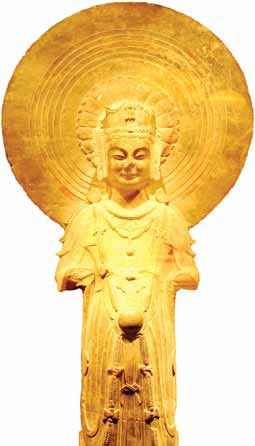|
|

Called the Oriental Venus de Milo, the lone Bodhisattva statue of the Northern Wei period (AD 386-534) is a precious relic of religious art in Shandong. |
As one of the important cradles of Chinese civilization, Shandong, in East China, is home to a rich collection of cultural relics and historical sites.
Based on the data of the third national cultural relics census conducted in 2011, Shandong has more than 50,000 registered unmovable cultural relics, including three world cultural heritage sites - Taishan Mountain, the Confucius Temple complex and the Great Wall of the Qi State (386-221 BC). It also has 101 key cultural relics under national protection and 687 under provincial protection.
The province hosts 195 museums of all kinds, which house up to 1.5 million relics and artifacts, including more than 10,600 national first-class treasures, topping the nation both in quantity and rarity.
Among them, Shandong Museum located in Jinan, capital of the province, stands out as China's largest comprehensive provincial museum.
"Shandong boasts a long history and splendid culture and is known as the hometown of Confucius, Mencius, ancient Chinese philosophers, and Sun Tzu, the author of the Art of War, who have left behind numerous precious historical relics," said Lu Wensheng, curator of the museum.
"The 139,277 treasures placed in the museum are all silent witnesses to past of the country and the province, ranging from oracle bones dating back to the Shang Dynasty (1600-1046 BC), to pottery of the Neolithic Age and bronze items of the Spring and Autumn Period (770-476BC)," he added.
One of the museum's top 10 treasures on display is an eggshell-thin black pottery cup. Unearthed in Weifang, Shandong province in 1960, it is a masterpiece of Longshan Culture, which existed in the area around 4,000 years ago in the late Neolithic period. The shiny long-handled cup, which is only 0.1 to 0.2 millimeters thick at its thinnest points, represents the best pottery-making technique in ancient China.
Another highlight is the 4,000 bamboo slips containing inscriptions on military strategy, including the earliest version of the Art of War. Known as "the holy book of warfare", the text dates back to the Western Han Dynasty (206 BC-AD 24).
They were excavated from a tomb of the Han Dynasty (206 BC-AD 220) in Yinque Mountain in the city of Linyi in 1972. The find was considered one of the top 100 archaeological discoveries in China in the 20th century.
The museum also has a large collection of Buddhist figures made from bronze, stone and ceramic, offering an overview of the full spectrum of Shandong Buddhist figurine art through the centuries from the Northern Wei (386-534) to Sui (581-618) dynasties.
Among them, the lone Bodhisattva statue of the Northern Wei period (AD 386-534) is a precious relic of religious art in Shandong. Found in Bo'xing county, the statue is carved in limestone and stands about 120 cm tall.
It is set against a circular nimbus with a lotus rosette. The statue is draped in pearls and ribbon cords while its skirt falls in delicate folds.It is called the Oriental Venus de Milo because it is armless and has a half-smiling face.
This is just a glimpse of the museum's rich collection. Currently, more than 4,500 relics are on display at the museum's 10 exhibition halls, which draw more than 2 million visitors annually.
Additionally, many local museums attract visitors with their different distinctive features, including the Weifang Kite Museum, the Zhucheng Dinosaur Museum as well as the Ancient Chinese Car Museum and the Qi State Historical Museum in Linzi, the capital of the ancient Chinese state of Qi more than 2,000 years ago.
These museums have not only attracted increasing numbers of visitors and researchers but also promoted international cultural exchanges. They have held many exhibitions in countries such as the United State, the United Kingdom, Australia, Japan and South Korea.
By Wang Qian (China Daily)
wangqian2@chinadaily.com.cn
(China Daily 08/30/2012 page24) |